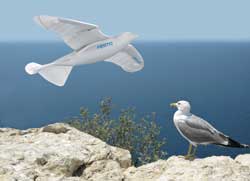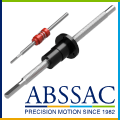
Posted to News on 10th Jun 2011, 12:48
Bionic SmartBird to launch itself at Hannover Fair
What do the herring gull and the elephant's trunk have to do with automation technology? Festo is providing the answer at the 2011 Hannover Trade Fair, where it is presenting future concepts that are inspired by nature and are put into practice through its Bionic Learning Network. With the SmartBird, engineers from Festo say they have succeeded in deciphering the flight of birds, thus accomplishing a further breakthrough in automation technology. Just as with the Bionic Handling Assistant - which in 2010 received the German Future Prize, a major international design award - Festo is focusing this year on energy efficiency and lightweight construction.

With the Bionic Learning Network and 66 new products on show, Festo is claiming to set the pace at the Hannover Trade Fair in numerous fields, from safe automation and intelligent mechatronics, up to new drive and handling technologies, energy efficiency and lightweight construction techniques.
The highlight for visitors will undoubtedly be to see the fascinating SmartBird in flight. One of the oldest dreams of mankind is to fly like a bird. No less fascinating is bird flight itself. Birds achieve lift and remain airborne using only the muscle power of their wings, with which they generate the necessary thrust to overcome the air resistance and set their bodies in motion; nature has ingeniously achieved the functional integration of lift and propulsion. Birds measure, control and regulate their motion through the air continuously and fully autonomously in order merely to survive. For this purpose they use their sensory organs.
Mystery solved
Bird flight was long shrouded in mystery. Many scientists failed in their attempts to understand how birds fly, and the secret remained unsolved. The research team from Festo has now claimed to have succeeded in unravelling the mystery. The key to its understanding is a novel movement that distinguishes the SmartBird from all previous mechanical flapping wing constructions and allows the ultra-lightweight, powerful flight model to take off, fly and land autonomously.
SmartBird flies, glides and soars through the air just like its real-life counterpart - the herring gull - with no additional drive mechanism. Its wings not only beat up and down, but also twist at specific angles. This is made possible by an active articulated torsional drive unit, which, in combination with a complex control system, makes for unprecedented efficiency in flight. Festo has thus succeeded for the first time in attaining an energy-efficient technical adaptation of this model from nature.
In developing the model, the engineers were able to draw on their wealth of experience and innovations. The experience gained with the Bionic Learning projects AirRay and AirPenguin was incorporated into the creation of SmartBird. The fascination of building an artificial bird that could take off, fly and land by means of flapping wings alone provided the inspiration for the development team.
Functional integration
An unusual feature of SmartBird is the active torsion of its wings and the fact that it dispenses with the use of additional lift devices. The aim of the SmartBird project was to achieve an overall structure that is efficient in terms of resource and energy consumption, with minimal overall weight, in conjunction with functional integration of propulsion and lift in the wings and a flight control unit in the torso and tail regions. Further requirements were excellent aerodynamics, high power density for propulsion, and maximum agility. The outcome is an intelligent biomechatronic overall system.
In practice, this system operates above all in an energy-efficient manner: the propulsion and lift, as intended, are achieved solely by the flapping of the wings and have a power requirement of only around 23W. SmartBird has a total weight of around 450g and a wingspan of 2m. Measurements have demonstrated an electromechanical efficiency factor of around 45 per cent and an aerodynamic efficiency factor of up to 80 per cent. SmartBird is therefore said to be an excellent example of functional integration and resource-efficient extreme lightweight design, and demonstrates optimal use of airflow phenomena. It will provide important design insights for the further optimisation of future generations of cylinders and valves.
The onboard electronics ensure precise wing control. In addition, the torsion control parameters can be adjusted and optimised in real time during flight. The wing flapping and twisting sequence is controlled to within only a few milliseconds and results in optimum airflow around the wings. The SmartBird flight model has no rotating parts on its exterior and therefore cannot cause injury. It is further pursuing an approach that already played an important role in the development of the Bionic Handling Assistant: human-machine interaction. This feature of both the Bionic Handling Assistant and SmartBird poses no risk to the human operator. SmartBird therefore joins the list of Festo's future-oriented technologies that are expected to find practical applications. Possible uses range from stroke wing generators in the energy sector and actuators for process automation.
Festo's SmartBird will be making its first public flight at the 2011 Hannover Fair, which takes place from 4-8 April 2011. Festo has a large 650m2 stand at the fair, number D07 in Hall 15.
Find out more about SmartBird and see a video preview of it in flight at www.festo.co.uk/bionic.

































